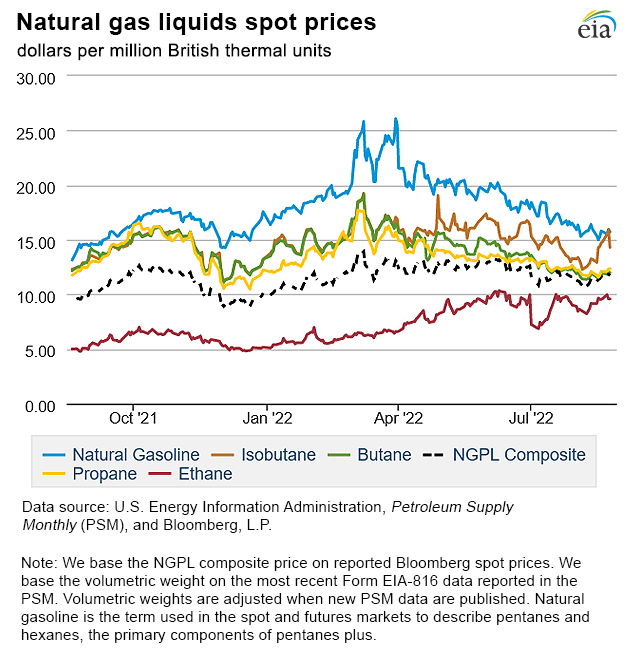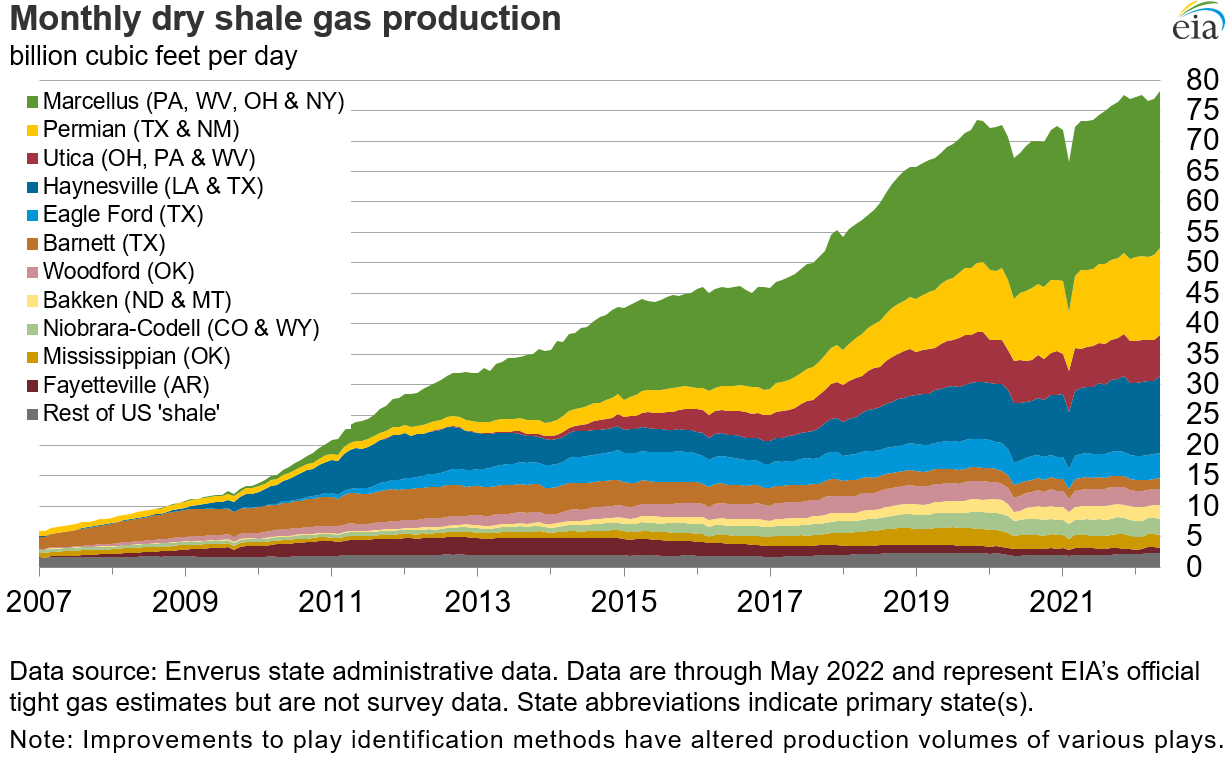In the News:
U.S. LNG export capacity is set to expand further as new projects begin construction
Liquefied natural gas (LNG) exports from the U.S. Lower 48 states began in February 2016, and since then both LNG export capacity and LNG exports have expanded to become the world’s largest as of July 2022. The seventh and latest U.S. LNG export project—Calcasieu Pass LNG—has placed in service all of its liquefaction trains as of August, ahead of the originally announced schedule. This additional capacity led to the United States becoming the world’s largest LNG exporter, with exports averaging 11.1 billion cubic feet (Bcf/d) in the first half of 2022. In addition to Golden Pass LNG, which started construction in 2019, two more projects in the U.S. Gulf Coast have recently reached a final investment decision (FID) and began construction.
While Golden Pass LNG is constructing standard-size liquefaction trains with peak LNG production capacity of up to 0.8 Bcf/d per train, both Plaquemines LNG and Corpus Christi Stage III use a modular technology, which includes mid-scale refrigeration trains allowing for a shorter project construction timeline. Calcasieu Pass LNG, which also uses mid-scale liquefaction technology, started LNG production 30 months after the FID—the shortest construction period of all U.S. LNG export projects to date.
Once completed, the three export projects currently under construction will expand U.S. LNG peak export capacity by a combined 4.9 Bcf/d nominal (5.7 Bcf/d peak) by 2025:
- Plaquemines LNG consists of 24 mid-scale trains, each with a baseload capacity of approximately 0.07 Bcf/d. Each liquefaction train is part of a two-unit block, for a total of 12 blocks, with a combined capacity of 1.6 Bcf/d baseload (1.8 Bcf/d peak).
- Corpus Christi Stage III is being developed at the site of the existing terminal with three liquefaction trains in operation. Each of the new 14 mid-scale trains under construction has a baseload capacity of 0.09 Bcf/d (0.11 Bcf/d peak). Each train is part of a two-unit block for a total of seven blocks with a combined capacity of 1.3 Bcf/d baseload (1.6 Bcf/d peak).
- Golden Pass LNG consists of three standard-size trains, each with a capacity of approximately 0.7 Bcf/d baseload (0.8 Bcf/d peak), for a total capacity of 2.0 Bcf/d (2.4 Bcf/d peak). Golden Pass LNG is being developed at the site of an existing regasification facility and will use shared infrastructure, which helps to reduce project costs and shorten the construction timeline.
The latest information on the status of U.S. liquefaction facilities, including expected online dates and capacities, is available in our quarterly database of U.S. LNG export facilities.
Market Highlights:
(For the week ending Wednesday, August 24, 2022)Prices
- Henry Hub spot price: The Henry Hub spot price fell 22 cents from $9.51 per million British thermal units (MMBtu) last Wednesday to $9.29/MMBtu yesterday.
- Henry Hub futures prices: The price of the September 2022 NYMEX contract increased 8.6 cents, from $9.244/MMBtu last Wednesday to $9.330/MMBtu yesterday. The price of the 12-month strip averaging September 2022 through August 2023 futures contracts climbed 11.4 cents to $7.659/MMBtu.
- Select regional spot prices: Natural gas spot prices fell at most locations this report week (Wednesday, August 17, to Wednesday, August 24). Price decreases ranged from $2.50 at El Paso South Mainline/North Baja to 10 cents at Chicago Citygate. At two of the few locations where prices increased week over week, the price rose by 62 cents at Algonquin Citygate and by 39 cents at Transco Zone 6 NY.
- Prices in California decreased this report week, as temperatures in California and the Desert Southwest fell relative to last week. The price at SoCal Citygate in Southern California decreased $2.34 from $12.10/MMBtu last Wednesday to $9.76/MMBtu yesterday. The price at PG&E Citygate in Northern California fell 38 cents, down from $10.42/MMBtu last Wednesday to $10.04/MMBtu yesterday. In the Desert Southwest, the Natural Gas Intelligence El Paso South Mainline/North Baja price fell $2.50 from $12.27/MMBtu last Wednesday to $9.77/MMBtu yesterday. Temperatures in Los Angeles, California, averaged 73°F, or 2°F below normal, compared with 77°F the prior report week, and in the Phoenix Area, temperatures averaged 91°F, nearly 4°F below normal. Natural gas consumption in California decreased by 0.3 billion cubic feet per day (Bcf/d), or 6%, which was led by a week-over-week decline of 12% (0.3 Bcf/d) in consumption in the electric power sector, according to data from PointLogic.
- The price at the Waha Hub in West Texas, which is located near Permian Basin production activities, fell 52 cents this report week, from $8.60/MMBtu last Wednesday to $8.08/MMBtu yesterday. The Waha Hub price traded $1.21 below the Henry Hub price yesterday, compared with last Wednesday when it traded 91 cents below the Henry Hub price. Kinder Morgan, operator of the El Paso Natural Gas pipeline, is performing maintenance at station Waha GE in Pecos County, Texas, between August 23 and August 26. Capacity at this point on the pipeline, which delivers natural gas from western Texas into the Desert Southwest and California, is reduced by approximately 500 million cubic feet per day.
- At the Algonquin Citygate, which serves Boston-area consumers, the price increased 62 cents week over week, from $8.54/MMBtu last Wednesday to $9.16/MMBtu yesterday. At the Transcontinental Pipeline Zone 6 trading point for New York City, the price increased 39 cents from $8.44/MMBtu last Wednesday to $8.83/MMBtu yesterday. Temperatures this week in the Boston Area and New York Central Park Area were on average 3°F above normal, averaging in the high 70s in both areas. Natural gas consumption in the Northeast increased 8% (1.2 Bcf/d), which was led by a 13% (1.1 Bcf/d) increase in consumption in the electric power sector, according to data from PointLogic.
- In the Appalachia region, the Tennessee Zone 4 Marcellus spot price increased 36 cents from $8.10/MMBtu last Wednesday to $8.46/MMBtu yesterday. Net natural gas flows from Appalachia to New York and New Jersey increased 5% (0.3 Bcf/d) week over week, according to data from PointLogic. The Eastern Gas South spot price rose 21 cents from $8.27/MMBtu last Wednesday to $8.48/MMBtu yesterday. The Eastern Gas South spot price reached a weekly high of $9.00/MMBtu on Tuesday, which is the highest level since 2008.
- International futures prices: According to Bloomberg Finance, L.P., weekly average futures prices for liquefied natural gas (LNG) cargoes in East Asia increased $9.06 to a weekly average of $59.01/MMBtu, and natural gas futures for delivery at the Title Transfer Facility (TTF) in the Netherlands, the most liquid natural gas spot market in Europe, increased $12.53 to a weekly average of $77.60/MMBtu.
- Natural gas plant liquids prices: The natural gas plant liquids composite price at Mont Belvieu, Texas, rose by 40 cents/MMBtu, averaging $11.75/MMBtu for the week ending August 24. The price of ethane rose 3%, following natural gas prices at the Houston Ship Channel, which rose 5%, resulting in the ethane premium to natural gas falling 11% week over week. The price of ethylene rose 2%, narrowing the ethylene to ethane spread by 6%. The Brent crude oil price rose 2%, pulling up the price of natural gasoline, which rose 1%. The propane price rose by 3%, so the propane discount to crude oil narrowed by 1%. The normal butane price rose by 2% and the isobutane price rose by 11%.
Daily spot prices by region are available on the EIA website.
Supply and Demand
- Supply: According to data from PointLogic, the average total supply of natural gas rose by 0.8% (0.8 Bcf/d) compared with the previous report week. Dry natural gas production remained unchanged week over week. Average net imports from Canada increased by 17.7% (0.8 Bcf/d) from last week.
- Demand: Total U.S. consumption of natural gas fell by 0.3% (0.2 Bcf/d) compared with the previous report week, according to data from PointLogic. Natural gas consumed for power generation declined by 0.7% (0.3 Bcf/d) week over week. Industrial sector consumption decreased by 0.6% (0.1 Bcf/d) week over week. In the residential and commercial sectors, consumption increased by 2.5% (0.2 Bcf/d). Natural gas exports to Mexico decreased 2.4% (0.1 Bcf/d). Natural gas deliveries to U.S. LNG export facilities (LNG pipeline receipts) averaged 11.1 Bcf/d, or 0.1 Bcf/d higher than last week.
Liquefied Natural Gas (LNG)
- Pipeline receipts: Natural gas deliveries to LNG export terminals in South Louisiana increased by almost 0.1 Bcf/d to 7.6 Bcf/d and were essentially flat in South Texas this week at 2.3 Bcf/d. Overall natural gas deliveries to U.S. LNG export terminals increased by 0.1 Bcf/d to 11.1 Bcf/d this report week.
- Vessels departing U.S. ports: Twenty-one LNG vessels (eight from Sabine Pass, five from Corpus Christi, four from Cameron, two from Cove Point, and one each from Calcasieu Pass and Elba Island) with a combined LNG-carrying capacity of 79 Bcf departed the United States between August 18 and August 24, according to shipping data provided by Bloomberg Finance, L.P.
- LNG export terminals: Freeport LNG announced a plan for resuming partial operations at the export facility on Quintana Island, near Freeport, Texas, since being shutdown following an incident on June 8. The plan anticipates initial production starting in early to mid-November and increasing to a sustained level of at least 2 Bcf/d by the end of November, which represents over 85% of the export capacity of the facility.
Rig Count
- According to Baker Hughes, for the week ending Tuesday, August 16, the natural gas rig count decreased by 1 rig from a week ago to 159 rigs. One rig was dropped in an unspecified producing region. The number of oil-directed rigs was the same as a week ago at 601 rigs. The Cana Woodford and the Permian each dropped one rig, and two rigs were added in unspecified producing regions. The total rig count now stands at 762 rigs, which is 259 more than the same week last year.
Storage
- The net injections into storage totaled 60 Bcf for the week ending August 19, compared with the five-year (2017–2021) average net injections of 46 Bcf and last year's net injections of 32 Bcf during the same week. Working natural gas stocks totaled 2,579 Bcf, which is 353 Bcf (12%) lower than the five-year average and 268 Bcf (9%) lower than last year at this time.
- According to The Desk survey of natural gas analysts, estimates of the weekly net change to working natural gas stocks ranged from net injections of 51 Bcf to 67 Bcf, with a median estimate of 59 Bcf.
- The average rate of injections into storage is 6% lower than the five-year average so far in the refill season (April through October). If the rate of injections into storage matched the five-year average of 9.8 Bcf/d for the remainder of the refill season, the total inventory would be 3,292 Bcf on October 31, which is 353 Bcf lower than the five-year average of 3,645 Bcf for that time of year.
See also:
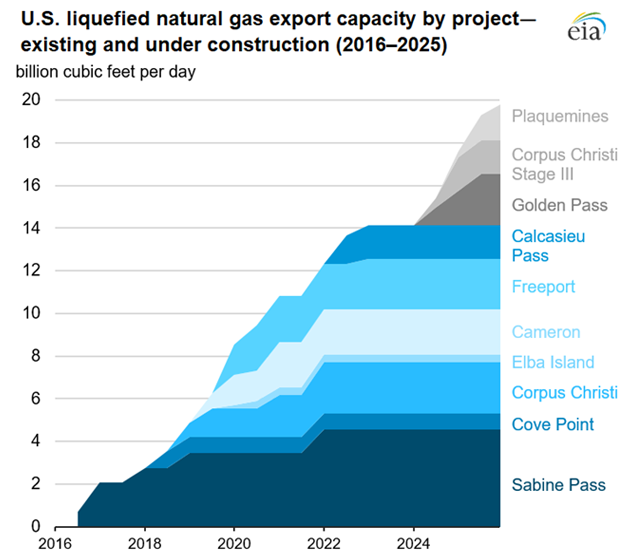 Data source: U.S. Energy Information Administration, Liquefaction Capacity File
Data source: U.S. Energy Information Administration, Liquefaction Capacity File Note: The chart shows U.S. LNG peak export capacity buildout by project. Online dates of LNG export projects under construction are our estimates based on trade press.
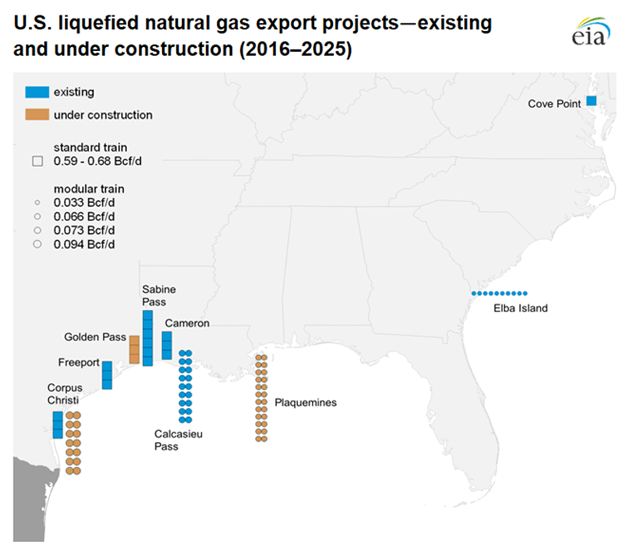 Data source: U.S. Energy Information Administration, Liquefaction Capacity File
Data source: U.S. Energy Information Administration, Liquefaction Capacity File Note: The map shows a range of nominal (baseload) capacities of standard-size and modular liquefaction trains.
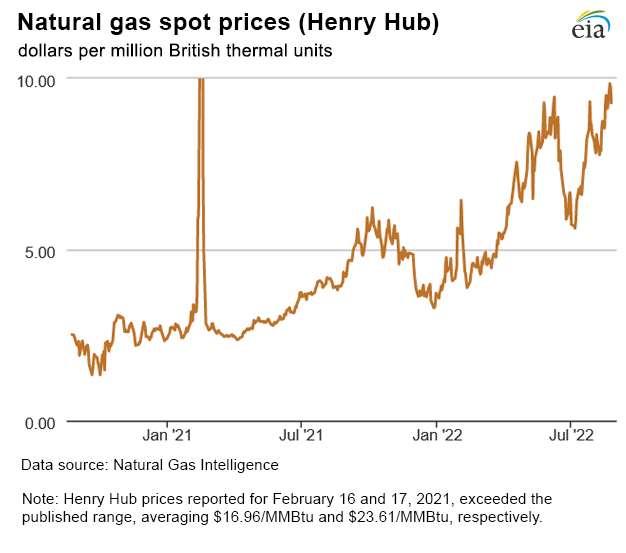
| Spot Prices ($/MMBtu) | Thu, 18-Aug |
Fri, 19-Aug |
Mon, 22-Aug |
Tue, 23-Aug |
Wed, 24-Aug |
|---|---|---|---|---|---|
| Henry Hub |
9.42 |
9.13 |
9.85 |
9.76 |
9.29 |
| New York |
8.53 |
8.13 |
8.87 |
9.41 |
8.83 |
| Chicago |
8.69 |
8.49 |
8.93 |
9.23 |
8.80 |
| Cal. Comp. Avg.* |
9.69 |
8.91 |
9.60 |
9.98 |
9.34 |
| Futures ($/MMBtu) | |||||
| September contract | 9.188 |
9.336 |
9.680 |
9.193 |
9.330 |
| October contract |
9.170 |
9.315 |
9.647 |
9.155 |
9.300 |
| Data source: Natural Gas Intelligence and CME Group as compiled by Bloomberg, L.P. *Avg. of NGI's reported prices for: Malin, PG&E Citygate, and Southern California Border Avg. |
|||||
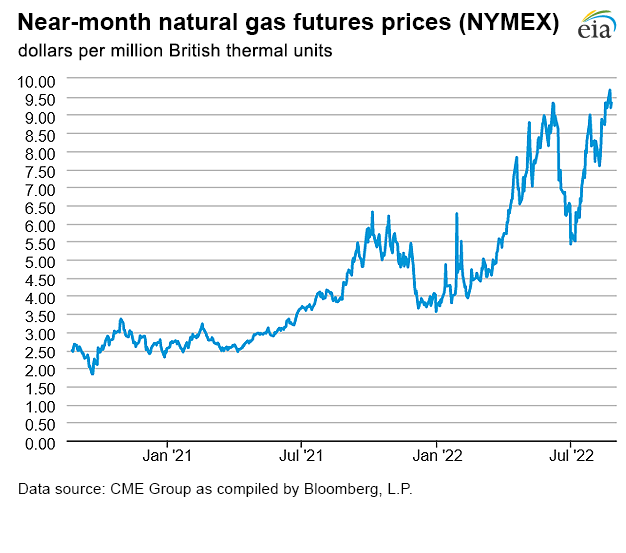
| U.S. natural gas supply - Gas Week: (8/18/22 - 8/24/22) | |||
|---|---|---|---|
Average daily values (billion cubic feet) |
|||
this week |
last week |
last year |
|
| Marketed production | 109.7 |
109.7 |
106.7 |
| Dry production | 97.0 |
97.0 |
94.3 |
| Net Canada imports | 5.4 |
4.5 |
4.8 |
| LNG pipeline deliveries | 0.1 |
0.1 |
0.1 |
| Total supply | 102.4 |
101.6 |
99.2 |
|
Data source: PointLogic | |||
| U.S. natural gas consumption - Gas Week: (8/18/22 - 8/24/22) | |||
|---|---|---|---|
Average daily values (billion cubic feet) |
|||
this week |
last week |
last year |
|
| U.S. consumption | 68.2 |
68.4 |
69.8 |
| Power | 38.2 |
38.5 |
40.3 |
| Industrial | 21.2 |
21.3 |
21.3 |
| Residential/commercial | 8.8 |
8.6 |
8.1 |
| Mexico exports | 5.6 |
5.8 |
6.2 |
| Pipeline fuel use/losses | 6.6 |
6.6 |
6.5 |
| LNG pipeline receipts | 11.1 |
11.0 |
10.7 |
| Total demand | 91.5 |
91.7 |
93.2 |
|
Data source: PointLogic | |||
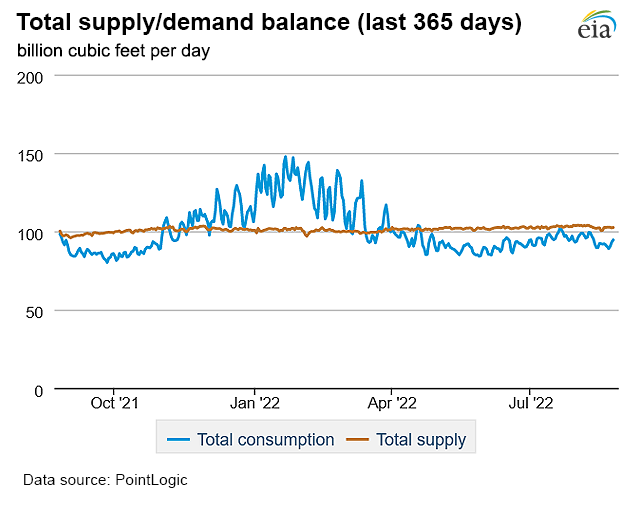
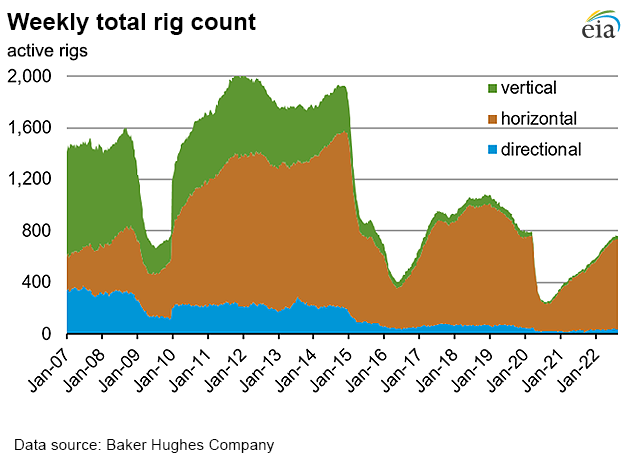
| Rigs | |||
|---|---|---|---|
Tue, August 16, 2022 |
Change from |
||
last week |
last year |
||
| Oil rigs | 601 |
0.0% |
48.4% |
| Natural gas rigs | 159 |
-0.6% |
63.9% |
| Note: Excludes any miscellaneous rigs | |||
| Rig numbers by type | |||
|---|---|---|---|
Tue, August 16, 2022 |
Change from |
||
last week |
last year |
||
| Vertical | 29 |
-6.5% |
52.6% |
| Horizontal | 694 |
0.1% |
52.9% |
| Directional | 39 |
0.0% |
30.0% |
| Data source: Baker Hughes Company | |||
| Working gas in underground storage | ||||
|---|---|---|---|---|
Stocks billion cubic feet (Bcf) |
||||
| Region | 2022-08-19 |
2022-08-12 |
change |
|
| East | 598 |
571 |
27 |
|
| Midwest | 714 |
684 |
30 |
|
| Mountain | 153 |
151 |
2 |
|
| Pacific | 243 |
248 |
-5 |
|
| South Central | 871 |
866 |
5 |
|
| Total | 2,579 |
2,519 |
60 |
|
| Data source: U.S. Energy Information Administration Form EIA-912, Weekly Underground Natural Gas Storage Report | ||||
| Working gas in underground storage | |||||
|---|---|---|---|---|---|
Historical comparisons |
|||||
Year ago (8/19/21) |
5-year average (2017-2021) |
||||
| Region | Stocks (Bcf) |
% change |
Stocks (Bcf) |
% change |
|
| East | 659 |
-9.3 |
689 |
-13.2 |
|
| Midwest | 786 |
-9.2 |
785 |
-9.0 |
|
| Mountain | 188 |
-18.6 |
186 |
-17.7 |
|
| Pacific | 241 |
0.8 |
272 |
-10.7 |
|
| South Central | 972 |
-10.4 |
1,000 |
-12.9 |
|
| Total | 2,847 |
-9.4 |
2,932 |
-12.0 |
|
| Data source: U.S. Energy Information Administration Form EIA-912, Weekly Underground Natural Gas Storage Report | |||||
| Temperature – heating & cooling degree days (week ending Aug 18) | ||||||||
|---|---|---|---|---|---|---|---|---|
HDDs |
CDDs |
|||||||
| Region | Current total |
Deviation from normal |
Deviation from last year |
Current total |
Deviation from normal |
Deviation from last year |
||
| New England | 3 |
-1 |
2 |
24 |
-10 |
-40 |
||
| Middle Atlantic | 3 |
0 |
3 |
35 |
-14 |
-41 |
||
| E N Central | 9 |
3 |
6 |
24 |
-22 |
-28 |
||
| W N Central | 2 |
-3 |
0 |
52 |
-8 |
-11 |
||
| South Atlantic | 0 |
0 |
0 |
76 |
-14 |
-31 |
||
| E S Central | 0 |
0 |
0 |
72 |
-15 |
-25 |
||
| W S Central | 0 |
0 |
0 |
126 |
4 |
8 |
||
| Mountain | 0 |
-6 |
-1 |
72 |
2 |
2 |
||
| Pacific | 0 |
-3 |
-1 |
74 |
30 |
4 |
||
| United States | 3 |
-1 |
2 |
62 |
-6 |
-19 |
||
|
Data source: National Oceanic and Atmospheric Administration Note: HDDs=heating degree days; CDDs=cooling degree days | ||||||||
Average temperature (°F)
7-day mean ending Aug 18, 2022
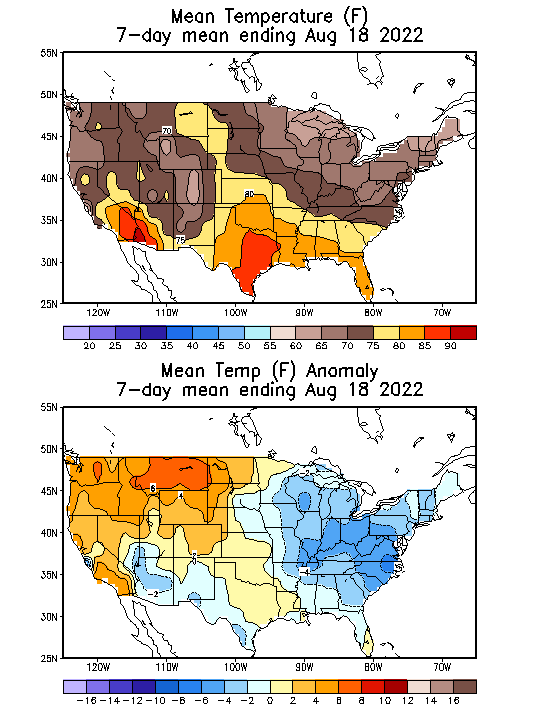
Data source: National Oceanic and Atmospheric Administration
Deviation between average and normal temperature (°F)
7-day mean ending Aug 18, 2022

Data source: National Oceanic and Atmospheric Administration

